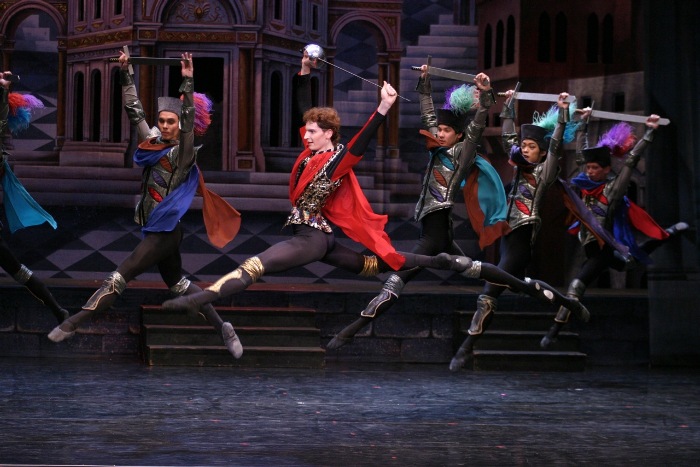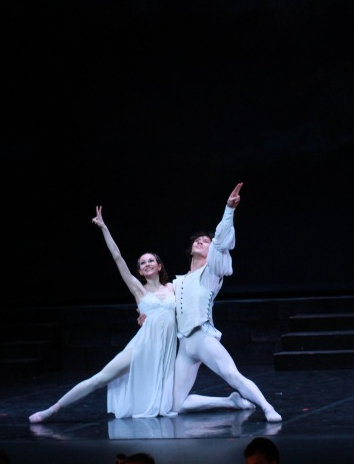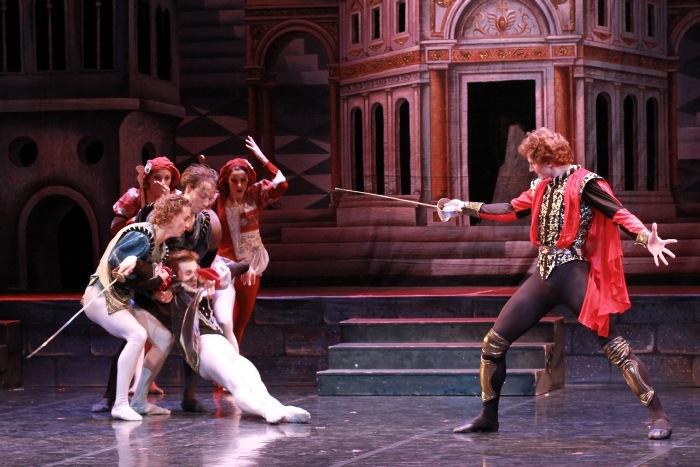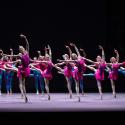The question with Moscow City Ballet is: should I judge them on what they are, or on what they claim to be? The touring company, a self-supporting private enterprise, takes productions of classic ballets (The Nutcracker, Swan Lake et al) round provincial theatres in this and a few other countries. By the standards of pure classical ballet, the product they peddle is decidedly second-, if not third-rate: the dancers come from the fringes of the classical scene in Russia and the Ukraine and the choreography is simple, and even then often poorly executed. Their website's claim that "the company is renowned for the perfection of its corps de ballet in the best traditions of the Russian school of classical ballet" looks like pure fiction.
And yet, and yet. Here I am again, for one thing: having seen MCB last year and got their measure, I wouldn't necessarily have chosen to go back, but the friend I took before had enjoyed our trip enough to ask me if we could go again this year, and I certainly hadn't hated it enough to deny her. Part of the attraction is being able to walk to the theatre: we, like many of the UK's population, live in a city never visited by the country's own classical ballet companies.
The chaps seemed to be suffering from an epidemic of what no-nonsense teachers in children's ballet schools call kipper feet
Another part is the live orchestra, which is a point hugely in the company's favour. The Moscow City Ballet orchestra under Igor Shavruk are not brilliant, but by and large they're not bad (especially when not being required by dubious production decisions to play at a snail's pace), and certainly up to giving competent renditions of well-loved Tchaikovsky and Prokofiev scores. The third factor in what, you might be gathering, is going to be my reasonably positive assessment of the company overall, was the ballet I saw last night, Romeo and Juliet.
When we took stock after the first act and decided we were quite enjoying ourselves, my friend said "you can't go wrong with Romeo and Juliet". While not 10 per cent accurate (see the ghastly Krysztof Pastor version for counter-evidence), I think it's probably true that a production that tells the story faithfully, makes a stab at putting heart into it, and uses the full Prokofiev score performed live, has a decent chance of being entertaining, however duff the dancing. The years the company's founder Victor Smirnov-Golovanov, spent dancing with the Bolshoi seem to have left a trace in the classic, Lavrovsky-like story treatment he used for his production, though certainly not in his lacklustre choreography.
As I noted last year regarding the Nutcracker, the choreography may be duff, but at least there is plenty of it and it's designed to entertain. The bombastic Montagues and Capulets march is in bigger productions usually performed as a stately formal dance, which may suggest the suffocating weight of the deadly enmity between Verona's feuding families, but also gives a rather muted visual effect at a moment of great musical drama. The Moscow City Ballet production instead put Tybalt (big, athletic Daniil Orlov) and some Capulet soldiers in quilted lamé breastplates and shinguards (pictured below), like Roman gladiators, and had them doing testosterone-fuelled double tours and lunges: a little bit daft, yes, but not boring.
 The women of the corps de ballet are, on the whole, better than the men: pretty enough on pointe, and close to being inoffensive, technique-wise, if only someone would drill them in keeping their legs at the same height and angle. The chaps seemed to be suffering from an epidemic of what no-nonsense teachers in children's ballet schools across the country call kipper feet, and their group dances included far too many sloppy high-kicks borrowed from the can-can instead of real ballet.
The women of the corps de ballet are, on the whole, better than the men: pretty enough on pointe, and close to being inoffensive, technique-wise, if only someone would drill them in keeping their legs at the same height and angle. The chaps seemed to be suffering from an epidemic of what no-nonsense teachers in children's ballet schools across the country call kipper feet, and their group dances included far too many sloppy high-kicks borrowed from the can-can instead of real ballet.
The design is quite easy on the eye, a commendable effort at Renaissance Italianate realised particularly well in the painted backcloth, which features a red-domed Florentine church amid staircases and buildings in an Escher-like harmonious variety of perspectives. Sitting near the front last year, I could see the cheapness of the stretch velour and lamé used in the costumes, but from further back, where I sat for Romeo and Juliet, that doesn't register: the costumes in fact mostly read as fairly tasteful, apart from possibly deliberate exceptions like Paris's stripy lilac satin doublet and Rosaline's candy-pink feather headdress (a near relative of those seen on carousel horses). Despite those kitschy costumes, Paris (Andrei Zhuravlev) and Rosaline (Lilya Orekhova) carried off the dancing honours: it was patently obvious even from their relatively brief appearances that both dancers were not only properly trained once, but also still cared - about line, about extension, about turnout. The same could not be said of Talgat Kozhabaev as Romeo, whose only virtue as a principal would appear to be his great size, all the better for swinging poor Yuliya Zhuravleva's Juliet about like a sack of potatoes in lift-heavy pas de deux (pictured right). Zhuravleva was better on her own: a sweet, girlish Juliet, who managed to be quite affecting in the last act when begging her parents not to force her to marry Paris. A slender, elegant dancer, she was clearly also well-trained once, but perhaps years of being flung about by Kozhabaev have taken their toll on her ability to care about making every single jété and arabesque neat.
Despite those kitschy costumes, Paris (Andrei Zhuravlev) and Rosaline (Lilya Orekhova) carried off the dancing honours: it was patently obvious even from their relatively brief appearances that both dancers were not only properly trained once, but also still cared - about line, about extension, about turnout. The same could not be said of Talgat Kozhabaev as Romeo, whose only virtue as a principal would appear to be his great size, all the better for swinging poor Yuliya Zhuravleva's Juliet about like a sack of potatoes in lift-heavy pas de deux (pictured right). Zhuravleva was better on her own: a sweet, girlish Juliet, who managed to be quite affecting in the last act when begging her parents not to force her to marry Paris. A slender, elegant dancer, she was clearly also well-trained once, but perhaps years of being flung about by Kozhabaev have taken their toll on her ability to care about making every single jété and arabesque neat.
Romeo and Juliet is a long ballet, especially when sections are taken at an unreasonably turgid rate, and by the end the poorly-executed, repetitive choreography was beginning to wear on me, while the addition of dry ice and "spooky" figures in black cloaks to the death scenes caused me to revise my previously positive assessment of the production design down a notch or two. Still, it was a live performance of something like classical ballet and available to many people for whom a better company's product would be financially or logistically inaccessible. If Moscow City Ballet can make this business model work in the notoriously expensive world of classical ballet, good luck to them.
- Moscow City Ballet are performing in Dublin in January and in York in April 2015.














Add comment